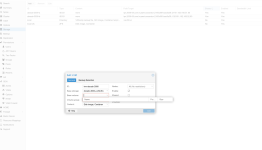Hi,
I have a strange issue setting up iSCSI connection betwwen PVE 8.3.2 and Huawei Ocenastore dorado 3000 v6 via iSCSI and then configuring multipath. Because of this is a test environment, I create only one LUN.
PVE has 4x10Gb Nics (Intel) and I setup two networks with 2 different VLANs:
I installed open-iscsi and lsscsi
From the GUI, Datacenter --> Storage --> Add --> iSCSI I successfully added the 2 Controllers as shown:

The problem is that, at this point PVE doesn't create a map in /dev/sdX.
This is the content of /etc/pve/storage.cfg :
This is the output of iscsiadm -m session :
This is the output of lsblk :
(Where are the iSCSI disks?)
This is the output of lsscsi :
This is the output of iscsiadm -m session -P3 :
As you can see there is no mapping in /dev/sdX
And in the System log:
If I do not have a mapping I can't configure LVM as you can see:

And finally I can't configure multipath....
Can someone help me, please?
Thank you
I have a strange issue setting up iSCSI connection betwwen PVE 8.3.2 and Huawei Ocenastore dorado 3000 v6 via iSCSI and then configuring multipath. Because of this is a test environment, I create only one LUN.
PVE has 4x10Gb Nics (Intel) and I setup two networks with 2 different VLANs:
- 192.168.51.50
- 192.168.52.50
- Controller A: 192.168.51.60
- Controller B: 192.168.52.60
I installed open-iscsi and lsscsi
From the GUI, Datacenter --> Storage --> Add --> iSCSI I successfully added the 2 Controllers as shown:

The problem is that, at this point PVE doesn't create a map in /dev/sdX.
This is the content of /etc/pve/storage.cfg :
Code:
dir: local
path /var/lib/vz
content iso,backup,vztmpl
zfspool: local-zfs
pool rpool/data
content rootdir,images
sparse 1
iscsi: dorado-3000-a
portal 192.168.51.60
target iqn.2006-08.com.huawei:oceanstor:2100c89f1aac8a39::21f01:192.168.51.60
content none
iscsi: dorado-3000-b
portal 192.168.52.60
target iqn.2006-08.com.huawei:oceanstor:2100c89f1aac8a39::1021f01:192.168.52.60
content noneThis is the output of iscsiadm -m session :
Code:
tcp: [1] 192.168.51.60:3260,7938 iqn.2006-08.com.huawei:oceanstor:2100c89f1aac8a39::21f01:192.168.51.60 (non-flash)
tcp: [2] 192.168.52.60:3260,7948 iqn.2006-08.com.huawei:oceanstor:2100c89f1aac8a39::1021f01:192.168.52.60 (non-flash)This is the output of lsblk :
Code:
NAME MAJ:MIN RM SIZE RO TYPE MOUNTPOINTS
sda 8:0 0 931.5G 0 disk
├─sda1 8:1 0 1007K 0 part
├─sda2 8:2 0 1G 0 part
└─sda3 8:3 0 930.5G 0 partThis is the output of lsscsi :
Code:
[0:0:0:0] disk ATA CT1000MX500SSD1 046 /dev/sda
[6:0:0:0] disk HUAWEI XSG1 6000 -
[7:0:0:0] disk HUAWEI XSG1 6000 -This is the output of iscsiadm -m session -P3 :
Code:
iSCSI Transport Class version 2.0-870
version 2.1.8
Target: iqn.2006-08.com.huawei:oceanstor:2100c89f1aac8a39::21f01:192.168.51.60 (non-flash)
Current Portal: 192.168.51.60:3260,7938
Persistent Portal: 192.168.51.60:3260,7938
**********
Interface:
**********
Iface Name: default
Iface Transport: tcp
Iface Initiatorname: iqn.1993-08.org.debian:01:c69dbccc6b64
Iface IPaddress: 192.168.51.50
Iface HWaddress: default
Iface Netdev: default
SID: 1
iSCSI Connection State: LOGGED IN
iSCSI Session State: LOGGED_IN
Internal iscsid Session State: NO CHANGE
*********
Timeouts:
*********
Recovery Timeout: 15
Target Reset Timeout: 30
LUN Reset Timeout: 30
Abort Timeout: 15
*****
CHAP:
*****
username: <empty>
password: ********
username_in: <empty>
password_in: ********
************************
Negotiated iSCSI params:
************************
HeaderDigest: None
DataDigest: None
MaxRecvDataSegmentLength: 262144
MaxXmitDataSegmentLength: 262144
FirstBurstLength: 73728
MaxBurstLength: 262144
ImmediateData: Yes
InitialR2T: Yes
MaxOutstandingR2T: 1
************************
Attached SCSI devices:
************************
Host Number: 6 State: running
scsi6 Channel 00 Id 0 Lun: 0
Target: iqn.2006-08.com.huawei:oceanstor:2100c89f1aac8a39::1021f01:192.168.52.60 (non-flash)
Current Portal: 192.168.52.60:3260,7948
Persistent Portal: 192.168.52.60:3260,7948
**********
Interface:
**********
Iface Name: default
Iface Transport: tcp
Iface Initiatorname: iqn.1993-08.org.debian:01:c69dbccc6b64
Iface IPaddress: 192.168.52.50
Iface HWaddress: default
Iface Netdev: default
SID: 2
iSCSI Connection State: LOGGED IN
iSCSI Session State: LOGGED_IN
Internal iscsid Session State: NO CHANGE
*********
Timeouts:
*********
Recovery Timeout: 15
Target Reset Timeout: 30
LUN Reset Timeout: 30
Abort Timeout: 15
*****
CHAP:
*****
username: <empty>
password: ********
username_in: <empty>
password_in: ********
************************
Negotiated iSCSI params:
************************
HeaderDigest: None
DataDigest: None
MaxRecvDataSegmentLength: 262144
MaxXmitDataSegmentLength: 262144
FirstBurstLength: 73728
MaxBurstLength: 262144
ImmediateData: Yes
InitialR2T: Yes
MaxOutstandingR2T: 1
************************
Attached SCSI devices:
************************
Host Number: 7 State: running
scsi7 Channel 00 Id 0 Lun: 0As you can see there is no mapping in /dev/sdX
And in the System log:
Code:
Jan 02 14:25:43 prx1-tex systemd[1]: Starting iscsid.service - iSCSI initiator daemon (iscsid)...
Jan 02 14:25:43 prx1-tex iscsid[8186]: iSCSI logger with pid=8187 started!
Jan 02 14:25:43 prx1-tex systemd[1]: Started iscsid.service - iSCSI initiator daemon (iscsid).
Jan 02 14:25:43 prx1-tex kernel: Loading iSCSI transport class v2.0-870.
Jan 02 14:25:43 prx1-tex kernel: iscsi: registered transport (tcp)
Jan 02 14:25:44 prx1-tex iscsid[8187]: iSCSI daemon with pid=8188 started!
Jan 02 14:25:58 prx1-tex kernel: scsi host6: iSCSI Initiator over TCP/IP
Jan 02 14:25:58 prx1-tex kernel: scsi 6:0:0:0: Direct-Access HUAWEI XSG1 6000 PQ: 1 ANSI: 6
Jan 02 14:25:58 prx1-tex kernel: scsi 6:0:0:0: Attached scsi generic sg1 type 0
Jan 02 14:25:59 prx1-tex iscsid[8187]: Could not set session1 priority. READ/WRITE throughout and latency could be affected.
Jan 02 14:25:59 prx1-tex iscsid[8187]: Connection1:0 to [target: iqn.2006-08.com.huawei:oceanstor:2100c89f1aac8a39::21f01:192.168.51.60, portal: 192.168.51.60,3260] through [iface: default] is operational now
Jan 02 14:26:51 prx1-tex kernel: scsi host7: iSCSI Initiator over TCP/IP
Jan 02 14:26:51 prx1-tex kernel: scsi 7:0:0:0: Direct-Access HUAWEI XSG1 6000 PQ: 1 ANSI: 6
Jan 02 14:26:51 prx1-tex kernel: scsi 7:0:0:0: Attached scsi generic sg2 type 0
Jan 02 14:26:52 prx1-tex iscsid[8187]: Could not set session2 priority. READ/WRITE throughout and latency could be affected.
Jan 02 14:26:52 prx1-tex iscsid[8187]: Connection2:0 to [target: iqn.2006-08.com.huawei:oceanstor:2100c89f1aac8a39::1021f01:192.168.52.60, portal: 192.168.52.60,3260] through [iface: default] is operational nowIf I do not have a mapping I can't configure LVM as you can see:

And finally I can't configure multipath....
Can someone help me, please?
Thank you


